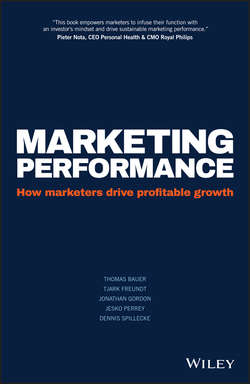Читать книгу Marketing Performance - Freundt Tjark - Страница 4
1 – Budget sizing: Combine multiple lenses to right-size your marketing budget
Why does budget sizing matter?
ОглавлениеHow much should you spend on marketing? It's the biggest question of all, and yet many companies settle on an easy answer. Most years, they spend whatever they spent the previous year. If they make adjustments at all, these are often a function of overall company performance: if the company is prospering, the budget goes up – sometimes beyond what is necessary or effective. And in times of stagnation or decline, marketing budget cuts are as certain as death and taxes, even if reduced marketing support is the last thing a troubled company needs. This is because a lot of companies still define their marketing budget as a percentage of past sales. In effect, budget sizing is decoupled from business requirements. Budgeting inertia is further aggravated by the fact that many companies buy media many months – if not years – in advance.1 If you are serious about turning the marketing function into a profit centre that contributes to the company's bottom line, put an end to these wasteful practices and introduce zero-based budgeting. First conceived in 1970 by Peter Pyhrr2 – a controller at Texas Instruments at the time – zero-based budgeting is about “reviewing every dollar in the annual budget”, 3 taking nothing for granted, and only signing off on budget positions that promise sufficient returns. Applied to marketing, this is nothing short of a paradigm shift – from a cost item to an investment opportunity.
The role of marketing is not a constant, nor is your mandate as the CMO. Markets change, and so does your company's competitive position. Even your brand profile and your business model are bound to evolve over time. Such changes need to be reflected in the size of the marketing budget. Consider, for example, the case of an insurance company that depends on frontline excellence. If sales force performance is lagging, you may have to intensify your marketing communication to drive short-term consumer pull while your peers in sales do their homework to fix the underlying issues. Now fast-forward five years into the future. Aggressive new market entrants have declared a price war, and your competitors are launching secondary brands to secure their share of the lower end of the market. In this new situation, you will want to invest in brand building to strengthen your brand, justify your price premium, and protect the profitability of your company.4 Now fast-forward 20 years into the future. Your brand is the top dog, and you are the market leader. You are finally able to decrease the marketing budget and allocate funds to other functions without putting your business at risk.
Whatever happens, we encourage you to put an end to “budgeting as usual”. The size of your budget should reflect your ambitions for future growth, rather than the past performance of the company. Start treating budgeting as a profitability driver and build your budget as an investment case rather than as a cost item.
1
Jonathan Gordon and Jesko Perrey, “Boosting returns on marketing investment,” McKinsey Quarterly, June 2005, http://www.mckinsey.com/insights/marketing_sales/boosting_returns_on_marketing_investment.
2
Peter A. Pyhrr, “Zero-base budgeting,” Harvard Business Review, November/December 1970, Volume 48, Number 6, pp. 111–121.
3
Matt Fitzpatrick and Kyle Hawke, “The return of zero-base budgeting,” McKinsey Quarterly, August 2015, http://www.mckinsey.com/insights/corporate_finance/the_return_of_zero-base_budgeting.
4
This is actually happening in many commoditized industries, from personal finance and airline travel to telecommunications and energy.
